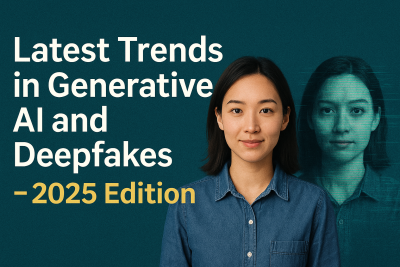Latest Trends in Generative AI and Deepfakes (2025 Edition)

How AI is Evolving—and the Risks That Come With It
Generative AI and deepfake technology have continued to dominate the tech and media landscapes in 2025. From real-time voice cloning to AI-generated videos, these innovations are reshaping content creation, communication, and even global policy.
In this article, we explore the latest developments in generative AI and deepfakes across four major areas:
🔹 Technological advancement
🔹 Use cases
🔹 Social risks
🔹 Legal regulations
🔍 What Are Generative AI and Deepfakes?
Let’s clarify the terminology:
- Generative AI refers to AI systems that can generate content—such as text, images, audio, and video—from user prompts. Examples include ChatGPT, Sora, Midjourney, and Runway.
- Deepfakes are AI-generated media that imitate real people’s faces or voices, often used to create fake videos or audio that look and sound eerily real.
While technically distinct, the two technologies are increasingly converging, with deepfakes now often considered a subset of generative AI.
⚙️ Technology Trends in 2025: What’s New?
✅ 1. Real-time Face & Voice Cloning
Live “face-swapping” and voice cloning have become highly realistic—even during Zoom calls or live streams. Real-time lip-syncing is now a reality.
✅ 2. Text-to-Video Generation Goes Mainstream
AI tools like OpenAI’s Sora and Runway allow anyone to generate high-quality, cinematic videos from a simple text prompt.
✅ 3. Instant Voice Cloning
Just a few seconds of voice data is enough to generate convincing audio clones. These tools are now free or low-cost—and widely accessible.
💡 Positive Use Cases of Generative AI and Deepfakes
| Field | Use Case |
|---|---|
| Education | Auto-generated AI lecture videos |
| Film & Media | Solo creators can produce full films |
| Accessibility | Restoring voices for ALS patients |
| Entertainment | Voice acting and VTubers powered by AI |
With lower production costs and automation, individual creators are thriving—but not without concerns.
⚠️ Growing Risks and Ethical Challenges
🔴 Rise in Deepfake Scams
AI-generated voice scams targeting the elderly—imitating grandchildren or family members—are on the rise.
🔴 Spread of Misinformation
Fake apology videos and political speeches made using deepfakes are going viral on social media, blurring the line between fact and fiction.
🔴 Ethical Dilemmas
Recreating deceased individuals, or generating explicit content without consent (so-called “AI revenge porn”), is stirring public outcry.
⚖️ Legal Regulations in 2025: How the World Is Responding
| Region | Key Regulation |
|---|---|
| 🇪🇺 EU | AI Act: Strict assessment required for high-risk AI |
| 🇺🇸 USA | Mandatory labeling of AI-generated political ads |
| 🇯🇵 Japan | Cultural Agency issues AI copyright guidelines and plans consent-based usage frameworks for voices and likenesses |
Expect a growing trend of mandatory labels like “This content was generated by AI.”
🔮 Looking Ahead: How Should We Prepare?
AI technology will continue to evolve at breakneck speed. To keep up, we must focus on:
- Media literacy: Can you tell real from fake?
- Ethical AI usage: Following clear usage guidelines
- Transparency: Knowing when AI is used, and making it visible
✅ Summary: Coexistence Is Key
| Topic | Takeaway |
|---|---|
| Technology | Multimodal AI and deepfake tools have advanced rapidly |
| Applications | Used in education, media, accessibility, and entertainment |
| Risks | Fake news, fraud, and ethical misuse are rising |
| Regulations | Stronger policies in EU, US, Japan are in effect |
Generative AI is no longer just a “cool toy”—it’s a force capable of reshaping entire systems.
The key is not to fear this change, but to understand it, use it responsibly, and help shape the AI-powered society of tomorrow.
📎Keywords
generative AI 2025 | deepfake news | AI-generated content | deepfake detection | voice cloning AI | text-to-video AI | AI copyright | AI regulation Japan | fake video risks
